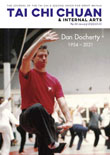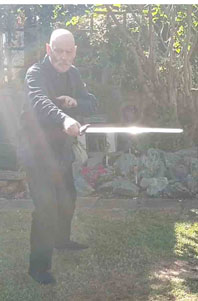| To read this email in your web browser click here |
 |
 |
 |
|
 |
Winter/Spring 2022 | ||
   |
Tiger form
john@bonsaitaichi.eu Telephone 07967 666 794 |
||
It doesn't matter whether your tai chi form went well or badly, the important thing is that you did it. T. T. Liang said: " If you rely too much on books, better to not have books. If you rely too much on teachers, better to not have a teacher. ." * Remember: a teacher can only point the way. (* T'ai Chi Ch'uan for Health and Self Defence T T Liang, Vintage Books.) Read the latest edition of Tai Chi Chuan & Internal Arts  Click the pic |
WHY TAI CHI? Ask a beginner what they expect from tai chi and the answer is likely to be a puzzled look. They will have seen all those graceful movements on YouTube and reckon that's for them. They may have other ideas but, most likely, won't have a clue about the real possibilities offered by tai chi. Health is a reason often given but this is likely based on a misunderstanding. Any form of exercise will improve your health. Tai chi and its partner system gigong are not magic. They will not 'cure' anything, though the practice might make you feel better about whatever it is that you've already got. Beginner or not, why we do tai chi is something that I don't believe many people think about. Certainly after they have been practising for a few years and, apart from the 'secrets' that their master is withholding, they reckon they have 'got it'. When I started I was asked to fill in a membership form. Name, address, the usual stuff, the form also asked what interested me about tai chi. Exercise: yes, (that was actually why I decided to take up tai chi). Meditation: yep! ( I already meditated every day and they said this was doing it while moving.) Martial art: Big, big NO! (I don't want to fight, I am not aggressive, I don't like confrontation, probably a bit of a coward.) What I didn't realise was that three years later I would actually understand the martial, self-defence applications of tai chi. I learned to not fight: a martial art at its highest level.1 There is no doubt that, when done properly, as an exercise system tai chi is hard to beat. It is difficult to say why. The movements are slow and non load-bearing so don't strain things too much. Soft is what we aim for. The weight shifting may have a lot to do with it and research has shown that it does improve balance.2 Also, unbelievably, it is aerobic. The way we breathe which forms, or should form, a large part of our practice is probably the reason for this. Some years ago when I hadn't run for years, my sister-in-law, on a visit from Canada, asked me to go out running as she didn't know the district. I agreed but expected to be gasping by the end of the street. On the contrary, my breathing was fine. Incidently so was my knee which had caused me to give up running in the first place. I had other problems but the lungs were absolutely ok. Breathing has always been rather taken for granted in the West. Certainly us lay people take it for granted and seldom think about it. Until recently the medical and scientific establishments also seemed barely to give it a thought either. Conversely in the Orient and in India breathing is a science, at times an art. Western medical practitioners, scientists and even the good old NHS are recognising the benefits of abdominal breathing. Let us not misunderstand this; if you breathe so that your belly expands rather than your upper chest, the air still passes through the whole of your lungs. It has been shown that this makes for better oxygenation of your body including internal organs. The NHS certainly recommends this type of breathing as an aid to recovery from surgery. Dr Peter Gryffin covers the theory in his book Mindful Exercise.3 We are not aware of anything before we take the first breath and we never know when we will take the last. In the great Islamic poem The Rubaiyat of Omar Kayyam the poet says: “We do not know if we'll breathe out the breath we breathe in now.” The Rubaiyat is about life and its transience and the impatience of us all. Then the thorny issue of self-defence. It is something that can put people off. A number of times I have had enquiries about classes. The conversation is going well and then 'martial art' gets mentioned and that's it. I never hear from the person again. So to be clear: tai chi is based on a martial art. Every move, every position has an application for defence or attack. We test these to give us a solid structure, a bit of a push, a bit of a shove but no more. Also, knowing why you are moving in a particular way into a particular position is a great help in learning the form.
So there can be many reasons why someone takes up tai chi and in
addition a tai chi class can be a great social evening. You do meet
some nice people – and there is always tea and biscuits.
1 – Mind over Matter. Shi Ming with Siao Weijia Trns: Thomas Cleary. Frog Ltd 2 – The Harvard Medical School Book of Tai Chi: Peter Wayne. Harvard Health Publications 3 – Mindful Exercise: Peter Anthony Gryffin, YMAA Publication Centre
To read more tai chi essays click here |
||




